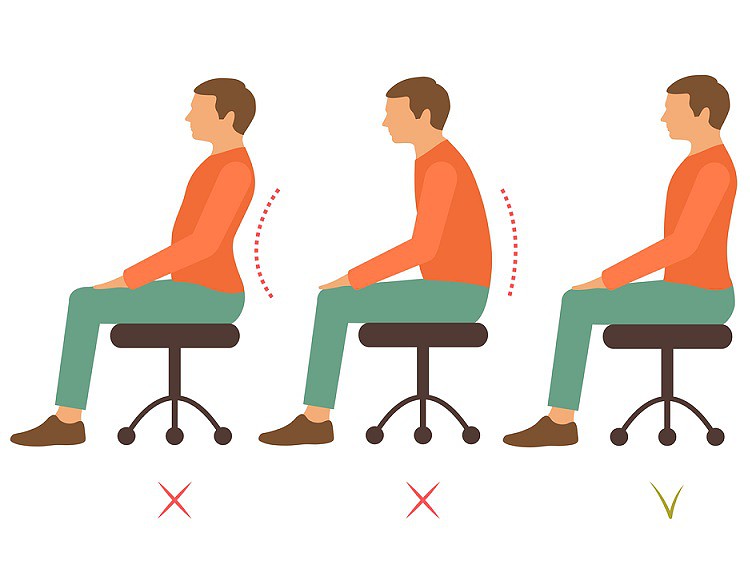For centuries, people have been sitting on the floor or using chairs or stools without back support.
In most circumstances, sitting on a chair without back support offers several benefits and helps promote good posture. However, keep in mind that the human body is not intended to sit for an extended period.
Nowadays, people are spending hours working on their computers and it’s becoming extremely difficult for them to maintain a healthy lifestyle.
Most are experiencing health issues such as neck pains, stiff bodies, and backaches because of their bad posture or slouched spines.
According to doctors, the incorrect or poor sitting position is the main culprit.
But if you plan on purchasing a chair without back support, this article will be helpful for you!
Table of Contents
Are chairs without backs better for you?
Chairs without backrests are popular even though people believe that sitting on this type of chair can disrupt your posture and affect your overall health.
It has been an ongoing debate whether chairs without backrests are good for you or not.
At the same time, these chairs offer great benefits which is why people are still using them today.
Benefits of Chairs Without Backs

Chairs without backrests promote good posture because it prevents you from slouching. These kinds of chairs are designed for people to be able to adjust their back and posture.
A high seating position helps reduce back pain because it allows the spine to curve naturally. It also puts your thighs in a downward slope which can help your back as well.
Slouching or bad posture leads to back and neck pains that can affect your overall health. In some cases, it can even lead to exhaustion and breathing problems!
When your back is relaxed, it improves blood circulation, which helps oxygen get to the brain faster, and organs function better because they are aligned.
Here are some benefits of a good posture:
- Prevents fatigue because your muscles are being used efficiently
- Reduces backache and muscular pain
- Prevents wear and tear of joints to prevent the onset of arthritis
- Prevents the spine from being in abnormal positions
Additionally, backless chairs assist in better engagement. A neurological study links movement and greater cognitive function, which means it keeps the brain focused.
There are also types of backless chairs that promote active sitting and allow users to rock or wobble—increasing muscle engagement. Moving our bodies helps increase productivity and engagement.
The Downside of Sitting on a Chair Without Back Support

There’s no doubt that chairs without back support offer clear advantages such as improving blood circulation, productivity, and engagement. But, there are also clear disadvantages—especially for older and younger people.
Sitting for an extended period can make you uncomfortable and will lead to back and neck pains. It also puts pressure on your veins, muscles, nerves, and blood vessels. The level of comfort it provides is less than a regular chair with a backrest.
There have also been safety concerns, especially for those who have children. High seats can cause accidents and injuries due to a lack of barriers to help protect from falls.
How to sit in a chair without back support?
Sitting on a chair without back support can get uncomfortable after a few minutes.
Training your body to have good posture when standing, lying, sitting, or walking puts less pressure and strain on your muscles and ligaments.

So if you already have one or if you are planning to purchase a chair without back support, here are some tips on how to sit on it comfortably without hurting your back!
Adjust Position of Chair
When you’re sitting on a chair without a backrest, one thing to remember is to make sure that you sit high to keep your back straight while keeping your feet on the ground. Your hips should be near the end of the stool and higher than your knees for utmost comfort.
Avoid leaving too much space between the table and the chair to prevent neck and shoulder problems.
Sit in a Forward Tilting Position

Ergonomic chairs without a backrest that use this sitting position are the saddle chair and the .
Thighs are slightly put downward and the anterior pelvic is slightly tilted. This reduces the stress in the lower back and keeps the discs in the middle position. This type of posture prevents back pains and helps ease ongoing back problems.
Don’t Stress Your Discs and Joints
When sitting, avoid crossing your legs. Instead of twisting your waist, turn your entire body to avoid stress on your discs and joints, if you need to get something. You should always keep your feet flat on the floor.
Stand Up

It’s not a good idea to sit on a chair for the whole day. You should stand up at least every 15 to 20 minutes throughout the day. Also, doing some stretching will help ease or prevent back pain!
When standing up, straighten your legs, without bending forward at the waist, then slowly extend your back.
Conclusion

We can’t deny that chairs without support offer health benefits and also help promote good posture because there will be no reason to slouch.
If you’ve been experiencing discomfort and fatigue working long hours every day, using an ergonomic chair without a backrest such as a saddle seat can help ease the pain.
Sitting on these types of chairs also strengthens your back muscles and core, which increases comfort and productivity.
Despite the benefits it offers, most ergonomic advisers still recommend choosing an ergonomic chair with a backrest to help keep you comfortable while working long hours.
Lack of back support may affect your posture and make you uncomfortable over time.
To get the maximum benefit of sitting on a chair without backs, you should know how to sit on it properly to prevent hurting your muscles, back, and neck!

My name is Vance, and I am the owner of To Ergonomics. Our mission is to improve your workflow by helping you create a supportive and welcoming environment. We hope that you’ll find what you’re looking for while you’re here.

